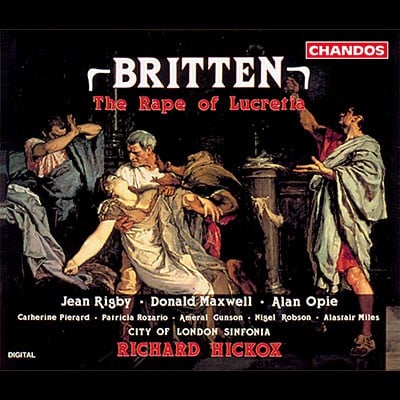Libretto by Ronald Duncan, after the play by André Obey (E,Cz,Fl,G,I,S,Sc)
2S,M,A,T,2Bar,B
1(=picc,afl).1(=corA).1(=bcl).1-1.0.0.0-perc(1):timp/susp.cym/gong/
BD/TD/SD/tgl/whip/tamb-harp-pft(=conductor)-strings (1.1.1.1.1)
Abbreviations (PDF)
Boosey & Hawkes
It was a combination of economic realities and aesthetic preferences that encouraged Britten to develop the concept of chamber opera, employing a small cast without chorus and an orchestra of just thirteen players. His first work in the new medium was The Rape of Lucretia, first performed just over a year after Peter Grimes, in 1946. There is, however, no loss of colour and atmosphere – indeed the pared-down textures produced an intensification of Britten’s operatic vision which was to serve him further in Albert Herring and The Turn of the Screw.
With the roles of the Male and Female Chorus, who comment on the action ‘out of time’ (as in Greek tragedy) and the use of solo piano accompaniment to accompany recitative passages, Lucretia achieves a certain ‘classical’ poise and detachment. However, Lucretia and Tarquinius are flesh-and-blood characters driven by real human emotions and desires (Lucretia’s music is surely some of Britten’s most sheerly beautiful) and the resulting amalgam is an opera of great musico-dramatic power and expressive richness.
Reproduced by kind permission of the Britten-Pears Library

English National Opera / Lionel Friend
Arthaus DVD 102021
Jean Rigby/Nigel Robson/Catherine Pierard/Donald Maxwell/Alastair Miles/Alan Opie/Patricia Rozario/Ameral Gunson/City of London Sinfonia/Richard Hickox
Chandos CHAN 9254

